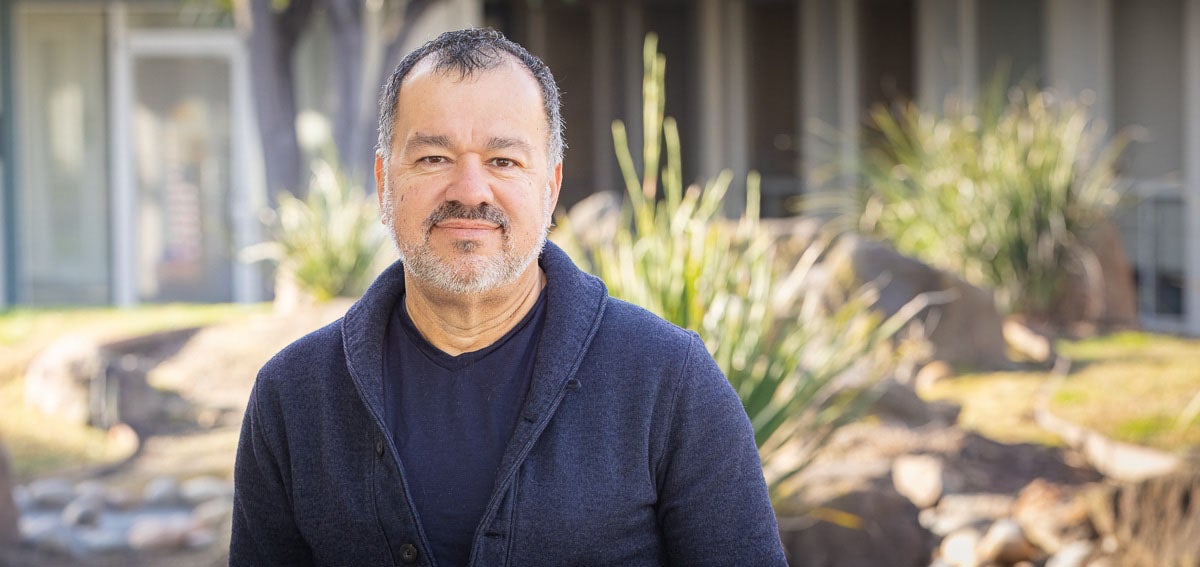
On November 30, 2021, JC was admitted to Zuckerberg San Francisco General Hospital for symptoms of heart failure. His legs were swollen, which can be a sign that the heart isn’t pumping properly, and he was having trouble breathing. He ended up spending seven days in the hospital with no one to talk to but the hospital staff. That’s when he decided it was time to turn his life around.
“Spending a week in a hospital room by yourself will do that to you. I had a lot of time for self-examination and introspection,” said JC, whose full name is being withheld to preserve his privacy.
His conclusion: it was time to stop his methamphetamine habit. A drug user for roughly two decades, JC, who is 52, had been using stimulants with increasing regularity for the last five years, to the point where he was taking a hit several times a day. He would use it in the morning to get motivated, before he went to work at his job as a stage technician, in the evening to unwind, or late into the night to party.
Despite his heavy drug consumption, JC said he never really felt it was a problem until he wound up in the hospital. He had several friends who also used methamphetamine and had died of heart failure, and “It really shook me,” he said. “I decided I wasn’t going to die like my friends had.”
Heart Plus Program
At the urging of his cardiologist, JC joined San Francisco General’s Heart Plus, a 12-week outpatient program that combines cardiovascular follow-up care with drug rehabilitation support. Stimulant drugs, such as cocaine and amphetamines, are known to cause and exacerbate cardiovascular problems, so the program’s goal is to improve patients’ health by addressing the two issues together.
“Stimulant use disorders complicate at least 15% of heart failure hospitalizations,” said Soraya Azari, MD, a UCSF associate clinical professor who cofounded Heart Plus. “At San Francisco General, we found methamphetamine use was an independent predictor of readmission for heart failure. There’s separate medical evidence that if you stop using methamphetamine, your heart failure can improve in terms of how well your heart squeezes and whether you have to keep coming back to the hospital.”
Patients enrolled in Heart Plus saw a cardiologist and an addiction specialist during twice-weekly appointments where the doctors would monitor their heart health, as well as counsel them about their drug use. Perhaps the most innovative aspect of the program is that the patients received rewards — either a $5 or $10 gift card or a positive affirmation — every time they showed up and every time they had a negative urine drug screen.
Contingency Management
The strategy of providing rewards for treatment compliance, known as contingency management, is rooted in a fundamental psychology theory known as operant conditioning. The idea is to reinforce the behaviors you want continued by rewarding people each time they do it. The other side of operant conditioning, which has been used with minimal success in traditional drug treatment strategies, is punishing people when they do something you want them to stop.
Contingency management “is about how to sculpt or change one’s behavior, and it relies on … the principles of positive reinforcement,” Azari said. “It generally has a really strong effect on perpetuating that behavior, and it seems to work better than things like punishment.”
Contingency management can be used to reinforce any type of behavior, but it’s proven particularly successful at helping people with stimulant use disorder. For opioid use disorder, there are three FDA-approved medications that help people stop or reduce their use. For people who struggle with cocaine or methamphetamine use, however, there are no targeted pharmacological treatments available.
While all illicit drugs activate the brain’s reward circuitry and prompt people to want to use the drug again and again, stimulants hijack the system more thoroughly than any other type of drug. Over time, normally enjoyable experiences, like food, music, or sex, become less rewarding in comparison. The goal of contingency management is to counteract the reinforcing properties of stimulant drugs by rewarding people for not using them. “You’re rewarding abstinence,” said Azari. “You’re creating this new built memory or learning that not using drugs can be positive and can be reinforcing.”
“Substance use disorders are chronic illnesses, just like hypertension, just like high cholesterol.“
—Soraya Azari, MD, cofounder of Heart Plus
The strategy works. According to one meta-analysis published in JAMA Psychiatry, 80% of studies testing contingency management for stimulant use showed the method was effective at helping people reduce their drug use. Another study conducted by the Department of Veterans Affairs found that people who regularly attended contingency management sessions tested negative for drugs more than 90% of the time.
“When you look at the studies comparing contingency management to other behavioral health interventions for stimulant use disorders, contingency management consistently demonstrates that it’s effective for helping people reduce their use of stimulants,” said Anton Nigusse-Bland, MD, a clinical associate professor at UCSF. “They use less frequently, and they’re able to maintain those gains for long periods of time after that contingency management intervention stops.”
CalAIM to Pay for Contingency Management Treatment
Contingency management is so effective at helping people with stimulant use disorder that California is set to become the first state Medicaid program to pay for the treatment. The pilot program, set to launch by early 2023, is part of the CalAIM (California Advancing and Innovating Medi-Cal) initiative, a multiyear plan to overhaul the state’s Medicaid program. Working with the Centers for Medicare & Medicaid Services (CMS), the California Department of Health Care Services (DHCS) received authorization for what they’re calling the Recovery Incentives Program. DHCS estimates the program will cost $58.5 million which includes federal funding.
“Under CalAIM, DHCS secured approval from CMS for the first time to cover contingency management as a benefit in the Medicaid program,” said Tyler Sadwith, deputy director of behavioral health at DHCS. “It’s really significant.”
The contingency management program will initially be piloted through 24 county behavioral health agencies already participating in the state’s Drug Medi-Cal Organized Delivery System (PDF), which launched in 2015 to expand and improve substance use disorder treatment through Medi-Cal. Those 24 counties represent a large share of both rural and urban geographic areas and include 88% of the Medi-Cal population.
The state’s Recovery Incentives Program will be structured slightly differently from Heart Plus, but the fundamentals are the same. To be eligible, people must have a stimulant use disorder and not be receiving inpatient treatment for it. The first 12 weeks of this Medi-Cal program will consist of twice-weekly meetings with the contingency management coordinator at a substance use disorder clinic. At each meeting, the participant will submit a urine sample, and for every negative drug test will receive a gift card. The gift cards will start at $10 and increase over the 12 weeks for consistently negative tests. A second 12-week period will focus on stabilization: the participants come only once a week but earn higher amounts for negative urine tests. In total, people can earn up to $599 for successfully completing the 24-week program.
If someone has a positive urine drug test, they will not be dropped from the program. “It’s important to acknowledge that recovery is a long process and people may or may not have lapses in their use along the way,” said Nigusse-Bland, who also works as a clinical consultant for DHCS. “We want to really support the engagement and continuing to show up, and so in the event that someone does have a positive drug test, the messaging is very clear: ‘Today wasn’t your day, but please come back next [week].’”
Participants in the recovery incentive program will also be able to receive other treatment services, including individual or group counseling, medications to help manage their use of other drugs, and connections to community resources. “It’s basically a comprehensive addiction treatment program,” Sadwith said. Those recovery support services will continue for up to six months after completion of the 24-week contingency management program.
Challenges and Possibility
Criticisms of contingency management often center around paying people with substance use disorders to not use drugs, and questions of whether people will start using again when the payments stop. But the rewards should be thought of not as money, per se, but like any other treatment for a chronic illness. And just like with any chronic disorder, the disease can wax and wane.
“Substance use disorders are chronic illnesses, just like hypertension, just like high cholesterol,” said Azari. “So we shouldn’t expect that you do 12 weeks of contingency management and then you’re cured for the rest of your life …. That’s not unlike other chronic illnesses where if you take the treatment away the disease might recur.”
In this way, JC, who hasn’t used methamphetamine since participating in the Heart Plus program in January 2022, is a little unusual. Many people receiving treatment for substance use disorders, including those participating in contingency management programs, have setbacks along the way. But his case also shows what’s possible when people are highly motivated to stop using methamphetamine and receive the support they need and deserve.
While the payments were a nice bonus, JC said that the most valuable part of Heart Plus was the support he got from Azari and the other doctors. “Talking about life without drugs or how to proceed forward … just discussing those topics with them really helped make it a reality,” he said. “You can’t go someplace if you don’t know it exists.”
Authors & Contributors

Dana G. Smith
Dana G. Smith, PhD, is a freelance health and science writer based in North Carolina. She has written for many publications, including Scientific American, Popular Science, Medium, The Atlantic, and The Guardian. Prior to pursuing a career in journalism, she earned a PhD in experimental psychology from the University of Cambridge.

Constanza Hevia H.
Constanza Hevia H. is a Chilean documentary photographer and filmmaker. She documents visual stories focused on social and cultural issues. Constanza uses photography, audio, and video as tools for social observation and as a language to communicate narratives that usually are not represented in mainstream media and society.
Based in both San Francisco and in Chile, she is a member of Women Photograph, Foto Féminas, and Diversify Photo. She works for a variety of nonprofits and organizations with social justice missions. Her work has been published in the San Francisco Chronicle, The Guardian, and the Wall Street Journal, among others.





